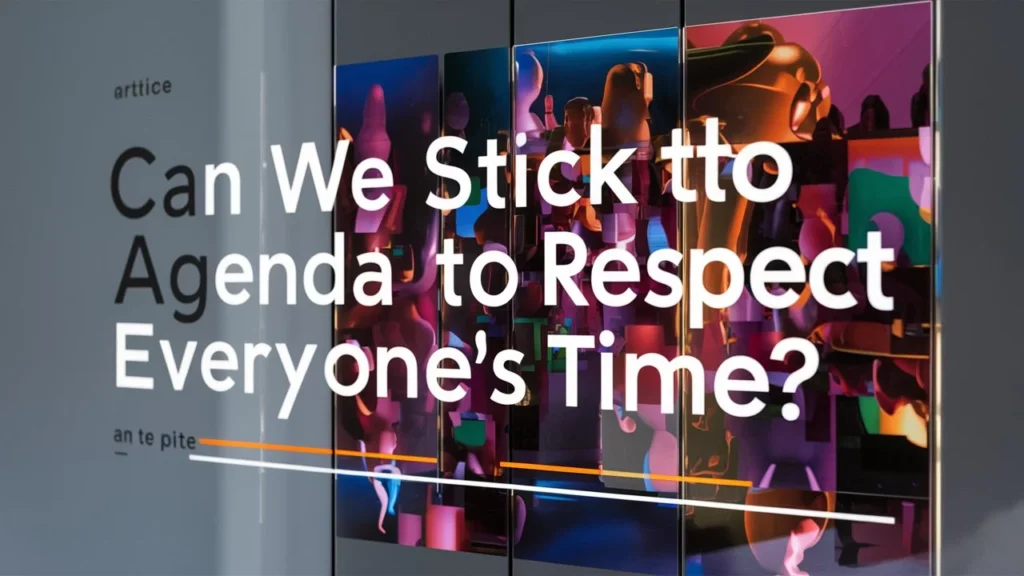Addressing the issue of someone talking too much in a professional setting can be a delicate task. It’s important to approach the conversation with tact and sensitivity to ensure that the individual doesn’t feel attacked or embarrassed. Effectively managing this situation requires a balance of honesty and diplomacy to maintain a positive working relationship and foster effective communication within the team. In this article, we’ll explore 20 professional ways to tell someone they talk too much, offering various approaches that respect the speaker’s feelings while addressing the need for more concise communication. These strategies will help you navigate this challenging conversation with grace and professionalism.
List of professional Ways to Tell Someone They Talk Too Much
- Let’s try to keep our comments brief to stay on track.
- We need to give others a chance to speak.
- Can we summarize our points to move forward?
- Let’s focus on the main points to keep the meeting efficient.
- How about we save some of this for offline discussion?
- I appreciate your enthusiasm, but we need to hear from everyone.
- Can we stick to the agenda to respect everyone’s time?
- Let’s ensure everyone gets a turn to contribute.
- Can we circle back to the main topic?
- I think we’re getting off-topic; let’s refocus.
- Let’s aim for concise input so we can cover all agenda items.
- Maybe we can revisit this in more detail later.
- I appreciate your input, but let’s give others a chance to share.
- To keep the meeting on schedule, let’s limit our comments.
- Can we condense our discussion to hit the key points?
- Let’s keep our contributions brief to move efficiently through the agenda.
- How about we continue this conversation after the meeting?
- Let’s make sure we have time for everyone’s ideas.
- We need to wrap up this point to stay on schedule.
- Let’s keep our input focused and brief to ensure a productive meeting.
1. Let’s Try to Keep Our Comments Brief to Stay on Track
Scenario: Team Meeting
During a team meeting, it’s important to ensure everyone has a chance to contribute.
“Everyone, let’s try to keep our comments brief to stay on track. We have a lot to cover today.”
This approach keeps the conversation focused and respectful.
2. We Need to Give Others a Chance to Speak
Scenario: Brainstorming Session
In a brainstorming session, encouraging diverse input can lead to more innovative ideas.
“John, you’ve shared some great points. We need to give others a chance to speak as well.”
This highlights the importance of inclusivity.
3. Can We Summarize Our Points to Move Forward?
Scenario: Project Discussion
When discussing project details, summarizing can help keep the conversation efficient.
“Sarah, you’ve provided a lot of details. Can we summarize our points to move forward with the next agenda item?”
This keeps the meeting productive without dismissing contributions.
4. Let’s Focus on the Main Points to Keep the Meeting Efficient

Scenario: Department Meeting
Department meetings often have multiple agenda items to cover.
“Team, let’s focus on the main points to keep the meeting efficient and respect everyone’s time.”
This emphasizes the need for brevity and focus.
5. How About We Save Some of This for Offline Discussion?
Scenario: Conference Call
On a conference call, extended discussions can disrupt the flow.
“Tom, you bring up important points. How about we save some of this for offline discussion to ensure we cover all our topics today?”
This redirects lengthy discussions to a more appropriate setting.
6. I Appreciate Your Enthusiasm, But We Need to Hear from Everyone
Scenario: Team Workshop
In a workshop setting, it’s essential to hear from all participants.
“Linda, I appreciate your enthusiasm, but we need to hear from everyone. Let’s make sure all voices are included.”
This fosters a collaborative environment.
7. Can We Stick to the Agenda to Respect Everyone’s Time?

Scenario: Weekly Meeting
Sticking to the agenda helps maintain the meeting’s structure.
“Folks, can we stick to the agenda to respect everyone’s time? We’ll make sure to address all points efficiently.”
This reinforces the importance of time management.
8. Let’s Ensure Everyone Gets a Turn to Contribute
Scenario: Roundtable Discussion
Roundtable discussions benefit from diverse viewpoints.
“Mike, you’ve made some great points. Let’s ensure everyone gets a turn to contribute to our discussion.”
This encourages equal participation.
9. Can We Circle Back to the Main Topic?
Scenario: Strategy Meeting
In strategy meetings, staying on topic is crucial for productive outcomes.
“Everyone, can we circle back to the main topic to make sure we stay on track with our strategy discussion?”
This gently redirects the conversation.
10. I Think We’re Getting Off-Topic; Let’s Refocus
Scenario: Planning Session
During planning sessions, staying focused ensures all elements are addressed.
“Team, I think we’re getting off-topic; let’s refocus on our planning objectives.”
This helps maintain the session’s direction.
11. Let’s Aim for Concise Input So We Can Cover All Agenda Items
Scenario: Board Meeting
Board meetings often have a packed agenda.
“Directors, let’s aim for concise input so we can cover all agenda items effectively.”
This sets a clear expectation for brevity.
12. Maybe We Can Revisit This in More Detail Later

Scenario: Status Update
Status updates should be concise to allow time for all updates.
“Jane, maybe we can revisit this in more detail later. Let’s move on to the next update.”
This defers in-depth discussions to a more suitable time.
13. I Appreciate Your Input, But Let’s Give Others a Chance to Share
Scenario: Feedback Session
In feedback sessions, it’s important to hear from all participants.
“Alex, I appreciate your input, but let’s give others a chance to share their feedback as well.”
This promotes a balanced discussion.
14. To Keep the Meeting on Schedule, Let’s Limit Our Comments
Scenario: Executive Meeting
Executive meetings need to be efficient and to the point.
“Executives, to keep the meeting on schedule, let’s limit our comments to the key points.”
This sets a tone of efficiency and respect for time.
15. Can We Condense Our Discussion to Hit the Key Points?
Scenario: Client Meeting
Client meetings should be concise and focused.
“Team, can we condense our discussion to hit the key points and respect our client’s time?”
This ensures the meeting stays productive and client-focused.
16. Let’s Keep Our Contributions Brief to Move Efficiently Through the Agenda
Scenario: Quarterly Review
Quarterly reviews often have extensive agendas.
“Everyone, let’s keep our contributions brief to move efficiently through the agenda.”
This helps maintain the review’s pace.
17. How About We Continue This Conversation After the Meeting?
Scenario: Training Session
Training sessions should stick to the curriculum.
“Chris, how about we continue this conversation after the meeting to keep our training on schedule?”
This offers a respectful way to manage time without cutting off valuable input.
18. Let’s Make Sure We Have Time for Everyone’s Ideas
Scenario: Innovation Meeting
Innovation meetings thrive on diverse input.
“Team, let’s make sure we have time for everyone’s ideas by keeping our comments concise.”
This encourages equitable participation.
19. We Need to Wrap Up This Point to Stay on Schedule

Scenario: Agenda-Driven Meeting
Staying on schedule is crucial in agenda-driven meetings.
“Folks, we need to wrap up this point to stay on schedule. Let’s move on to the next item.”
This ensures all agenda items are covered.
20. Let’s Keep Our Input Focused and Brief to Ensure a Productive Meeting
Scenario: Strategic Planning Session
Strategic planning sessions benefit from focused and brief input.
“Everyone, let’s keep our input focused and brief to ensure a productive meeting.”
This maximizes the effectiveness of the session.
Addressing the issue of someone talking too much in a professional setting requires tact and respect. These 20 phrases offer various ways to manage conversations effectively while maintaining a positive and collaborative environment. By using these alternatives, you can ensure that meetings and discussions remain productive, inclusive, and respectful of everyone’s time.










